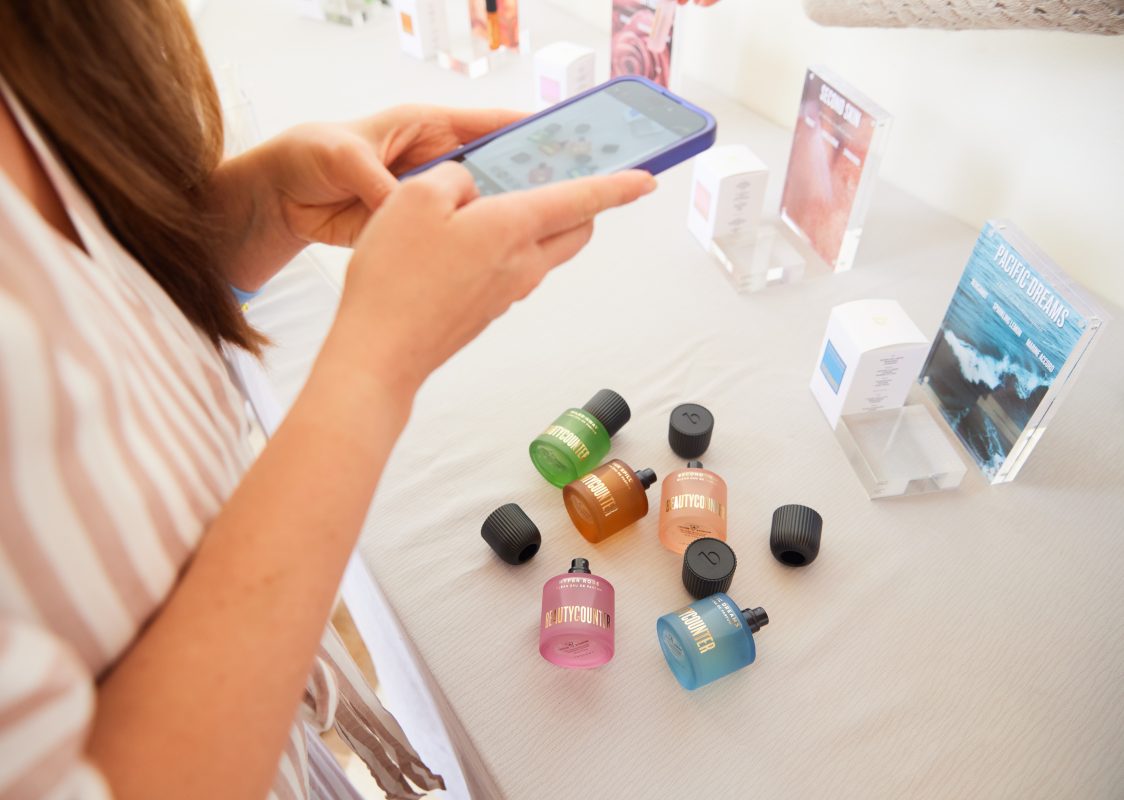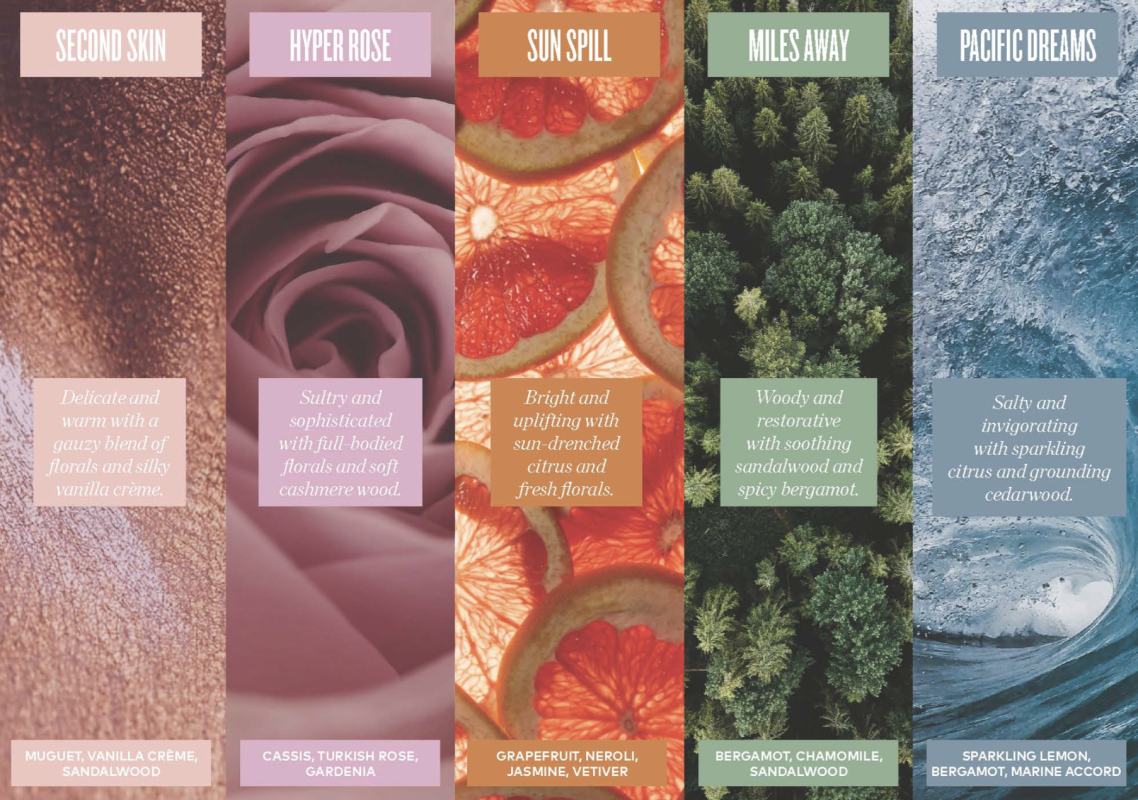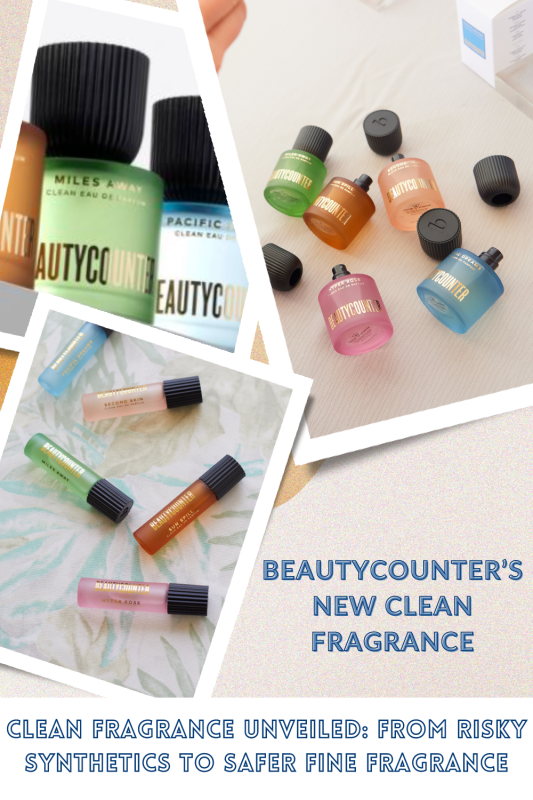Let’s unlock the secrets of clean fragrance and safer scents for a healthier tomorrow, shall we?! It’s time to rethink your relationship with fragrance and allow the scents you choose to not only tell a story, but also prioritize the well-being of both you and the environment.
Fragrance has played a pivotal role in human history, weaving its aromatic threads through ancient civilizations, cultural rituals, and personal expressions. However, as our fascination with scents has evolved, so too has the dark side of the fragrance industry. In this blog post, we’ll delve into the history of fragrance, its transformation into a multi-billion dollar industry, and the unsettling truth about the dangers associated with synthetic scents, including endocrine disrupters, carcinogens, and allergens.
While peeling back the layers of the fragrance industry, I’ll also provide insight and recommendations on how to dodge fragrance most of the time but also embrace some new clean fragrance options that out perform any of the other clean perfume options currently available!

The History of Fragrance
The use of fragrance dates back thousands of years, with ancient civilizations like the Egyptians, Greeks, and Romans employing aromatic oils, herbs, and resins for religious ceremonies, skincare, and personal adornment. As trade routes expanded, so did the availability of exotic spices and ingredients, contributing to the globalization of fragrance.
During the Renaissance, the art of perfumery flourished in Europe. Perfumers began to distill essential oils and blend them into complex compositions, creating bespoke scents for royalty and the elite. However, it wasn’t until the 19th century that synthetic fragrances emerged, thanks to advances in organic chemistry.
The Synthetic Revolution
The late 19th and early 20th centuries saw the rise of synthetic fragrance compounds, allowing perfumers to create an endless array of scents. While synthetic fragrances brought innovation and affordability, they also opened the door to a host of health concerns.
I don’t want to camp out here too long or sound too fear mongery but it is important to know WHY it’s generally wise to avoid most synthetic fragrances. It was just a little over five years ago when I was still wearing perfume. My go-to scent was Dolce & Gabanna Light Blue and a lesser popular but incredibly sexy Gilly Hicks perfume. The bottle still sits in my closet because I can’t bear the idea of throwing it away but I also can’t wrap my mind around intentionally spraying endocrine disrupters all over my body. So on that note…
What are the Hidden Dangers of Fragrance?
Endocrine Disrupters: Synthetic fragrances often contain phthalates, a group of chemicals used to enhance the longevity of scents. Phthalates have been linked to endocrine disruption, interfering with the body’s hormonal balance. Research suggests a potential association between phthalate exposure and reproductive issues, including infertility and developmental abnormalities (1).
Carcinogens: Some fragrance ingredients have been identified as potential carcinogens. For instance, synthetic musks and certain aldehydes have raised concerns about their impact on human health. The long-term exposure to these compounds, often present in perfumes and scented products, has been associated with an increased risk of cancer (2).
Allergens: Fragrances can contain a multitude of allergenic compounds that may trigger skin irritation, respiratory issues, or allergic reactions. Common allergens in synthetic scents include limonene, linalool, and coumarin. These substances can be particularly problematic for individuals with sensitivities or allergies. (3)
What are other sources of fragrance other than perfume or cologne?
Beyond the allure of perfumes and colognes, synthetic fragrances permeate our daily lives through seemingly harmless products, concealing a cocktail of potential health hazards. Let’s uncover a few common sources of synthetic fragrance and explore ways to reduce exposure to harmful ingredients.
Conventional Cleaning Products: Conventional household cleaning products often boast scents that promise a fresh and clean home. However, these fragrances often contain a blend of synthetic compounds, including phthalates and volatile organic compounds (VOCs). These chemicals can contribute to indoor air pollution and have been linked to respiratory issues.
Solution: Opt for cleaner alternatives like Branch Basics, a brand committed to transparency and using plant-derived ingredients. Their fragrance-free options ensure a safer cleaning experience without compromising efficacy.
Air Fresheners and Wall Plug-ins: Air fresheners and plug-in devices promise to eliminate odors and create a pleasant ambiance. Unfortunately, many of these products harbor synthetic fragrances laden with phthalates and other potentially harmful substances. Continuous exposure to these chemicals may contribute to long-term health issues.
Solution: Embrace natural alternatives like essential oils. A diffuser can disperse your favorite scents without the hidden dangers of synthetic fragrances. Open windows regularly to let in fresh air and help eliminate indoor pollutants.
Although it’s important to understand the pervasive nature of synthetic fragrances and be empowered to make informed choices, it’s also not completely fair to write off ALL fragrance entirely.
After many years of not wearing any perfume (and honestly not even missing it at this point), I’ve begun to dabble in safer fine fragrance. Beautycounter, a B Corporation that I have partnered with for over five years, is embarking on disrupting the fragrance industry this Spring.
Let’s dig in to what makes Beautycounter’s clean fragrance a safe and high-performing option!
In 2023, the fine fragrance market reached $8.2 billion dollars in sales* but it’s very underrepresented in the clean beauty space. Beautycounter saw an opportunity to leverage over a decades worth of education and advocacy work to bring a truly fine clean fragrance to the market.
*Circana Beauty Insider Report Total Measured Market, Annual 2023
What makes Beautycounter's fragrance safer?
There is full ingredient transparency! Beautycounter lists every ingredient used in this product. This is part of the reason I joined Beautycounter back in 2018 (I share more here about how working with this company has been the biggest surprise blessing of my career!)
There is unparalleled and rigorous safety screening on all their products, including fine fragrances. The fine fragrances are made with a blend of natural and safer synthetic ingredients, all of which have been screened against 23 human health and environmental endpoints.
Additionally, they are formulated without multiple ingredients commonly used in fine fragrance. These include: diethyl phthalate (DEP), a potential hormone disruptor; styrene, a known and potent human carcinogen; BHT, a known respiratory irritant, and oxybenzone, a skin irritant and hormone disruptor that can be found in fragrances.
Beautycounter’s in-house team of experts engaged with a leading, globally recognized external toxicology firm as needed to help support our rigorous safety standards.
You can’t find better industry-leading standards. There are over 2,800 questionable ingredients never used in Beautycounter’s formulations, including multiple ingredients commonly used in fine fragrances.
Their responsible sourcing efforts are second to none. For example, there is high demand of sandalwood as it is one of the most precious essential oils in the fragrance industry. It has led to exploitation and an exhausted supply. For our Beautycounter’s eau de parfums, they chose to use a safer synthetic musk (Oxacycloheptadec-10-en-2-one) and combined
it with upcycled Texas cedarwood oil to re-create the warm, creamy undertones that natural sandalwood essential oil is known for. The safer synthetic musk (Oxacycloheptadec-10-en-2-one) was also selected as a clean alternative to diethyl phthalate, a known endocrine disruptor and reproductive toxicant commonly used as a fragrance fixative to enhance on-skin longevity.
Full transparency: After giving up perfume so long ago, I wasn’t initially super jazzed about Beautycounter launching this new category. I’m at a point where I don’t actually miss wearing perfume but this launch is NOT about me. Plus, after receiving copious amounts of training on the scents, formulations and all the incredible science and efforts that went into these scents to make them safe, sustainable and beautiful- I’m all in. I actually ordered ALL of the full size bottles, roll-ons and even ordered samples (request yours here!).
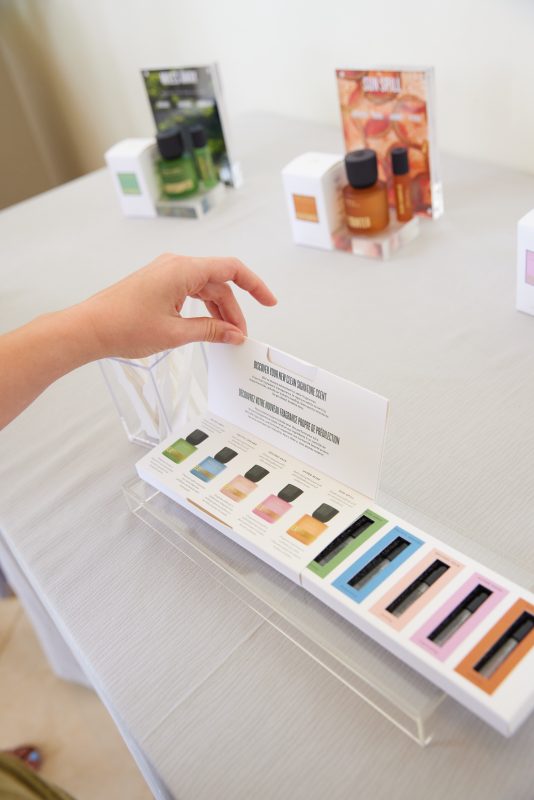
Here’s a breakdown of all five scents plus a few of my opinions after trying them! I understand how deeply personal fragrance is and I’m here to help you land on the scents you’re going to absolutely love and match your mood for that day. Also, don’t forget thatBeautycounter has a no questions asked 60 day return policy which extends to fine fragrance as well, just in case you don’t end up loving what you chose!


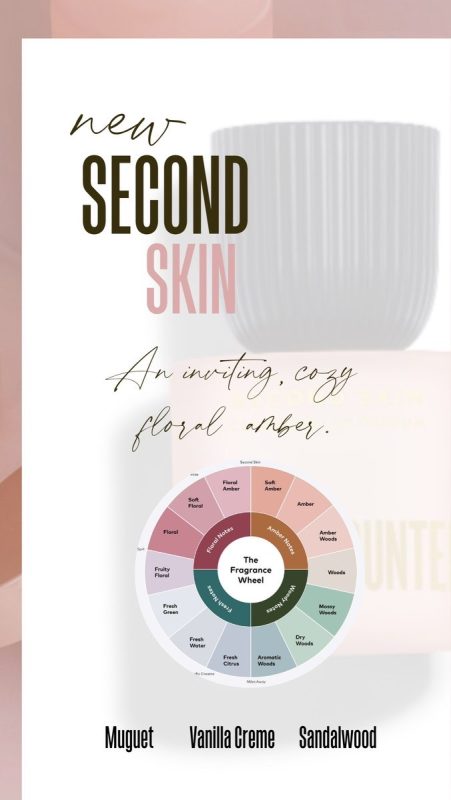

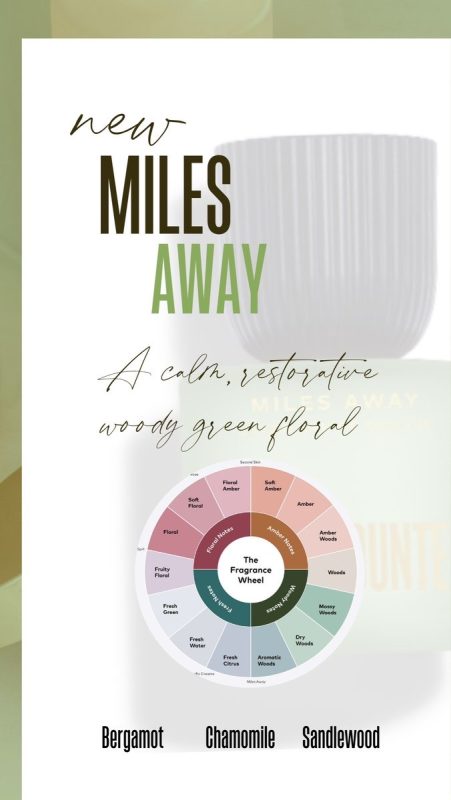

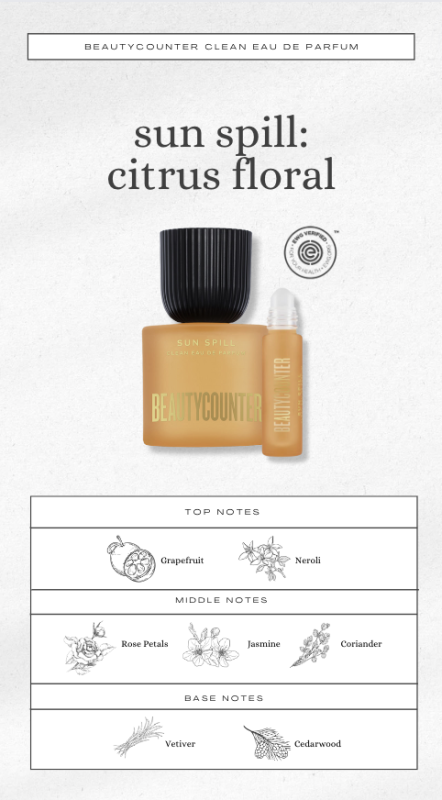



Hyper rose: Soft Floral. Not your grandma’s rose perfume! Sultry and sophisticated with full-bodied florals and soft cashmere wood. Juicy apple blossom, sweet gardenia, and tangy cassis cut through a blooming, full-bodied bouquet of Turkish rose, wrapped in cashmere wood for a warm and sultry softness.
Sun Spill: Citrus Floral. Inspired by the first days of summer! This one is a nod to Beautycounter’s signature citrus floral scents in many beloved products. Bright and uplifting with sun-drenched citrus and fresh florals. Bright, uplifting notes of grapefruit and sweet neroli shine through a lush blend of rich jasmine, velvety rose, and spicy coriander, paired with grassy vetiver for a freshly cut finish. We got a preview of this one in our holiday sets and I liked it BUT I like it even more now after they made a few more tweaks. It’s even more well-rounded now and definitely going to be one of my go-tos when feeling in a bright and sweet mood!
Second Skin: Soft Amber. Cue the Sultry vibes! Think delicate and warm with a gauzy blend of florals and silky vanilla crème. Layers of sweet citrus peek through a gauzy and elegant blend of white jasmine, silky vanilla crème, and dewy, dainty muguet infused with comforting notes of buttery-soft sandalwood. This is going to be my date-night go-to!
Pacific Dreams: Citrus Aquatic (My favorite!). Reminds me of Dolce & Gabanna Light Blue meets Davidoff’s Cool Water. The former was my signature scent in my 20’s and I wore the latter in high school so no surprise in my late 30’s I’m loving Pacific Dreams! Inspired by Beautycounter’s roots as an L.A. brand by the Pacific Ocean. Salty and invigorating with sparkling citrus and grounding cedarwood. A sparkling blend of lemon and bergamot bring a warm and sunny sweetness to the salty aromas of marine accord elevated by fresh Egyptian jasmine, crisp musk, and grounding cedarwood. I have a feeling this is going to be the most popular one!
Miles Away: Green Woods. This fragrance draws its inspiration from the Japanese tradition of Forest Bathing and is like a calming walk through the forest. Woody and restorative with soothing sandalwood and spicy bergamot. Zesty notes of lemon and Italian bergamot bring balance to a warm and woody blend of sandalwood, cedarwood, and juniper berry, infused with fresh jasmine and calming chamomile. We also had this one at holiday and honestly, I didn’t love it. It had way too much of a Christmas tree vibe for me, BUT like Sun Spill, it’s also been tweaked and refined. The notes are smoother and I now smell the zesty lemon notes and have reached for this one when I want to feel powerful and confident.
I so hope all the background on fragrance along with the evolution of the industry and Beautycounter’s new fine fragrance launch has you rethinking your relationship with fragrance! It’s time for the scents you choose to not only tell a story, but also prioritize the well-being of both you and the environment. I’m so excited that fragrance and safety can finally coexist harmoniously and am here to help educate, advocate and empower you to make one safer swap at a time!
Pin for later:
Sources
Hauser, R., & Calafat, A. M. (2005). Phthalates and human health. Occupational and Environmental Medicine, 62(11), 806–818.
- Dodson, R. E., Nishioka, M., Standley, L. J., Perovich, L. J., Brody, J. G., & Rudel, R. A. (2012). Endocrine disruptors and asthma-associated chemicals in consumer products. Environmental Health Perspectives, 120(7), 935–943.
- Schnuch, A., Uter, W., Geier, J., & Lessmann, H. (2007). Contact allergy to fragrances: current patch test results (2005-2008) from the Information Network of Departments of Dermatology. Contact Dermatitis, 60(2), 65–71.

